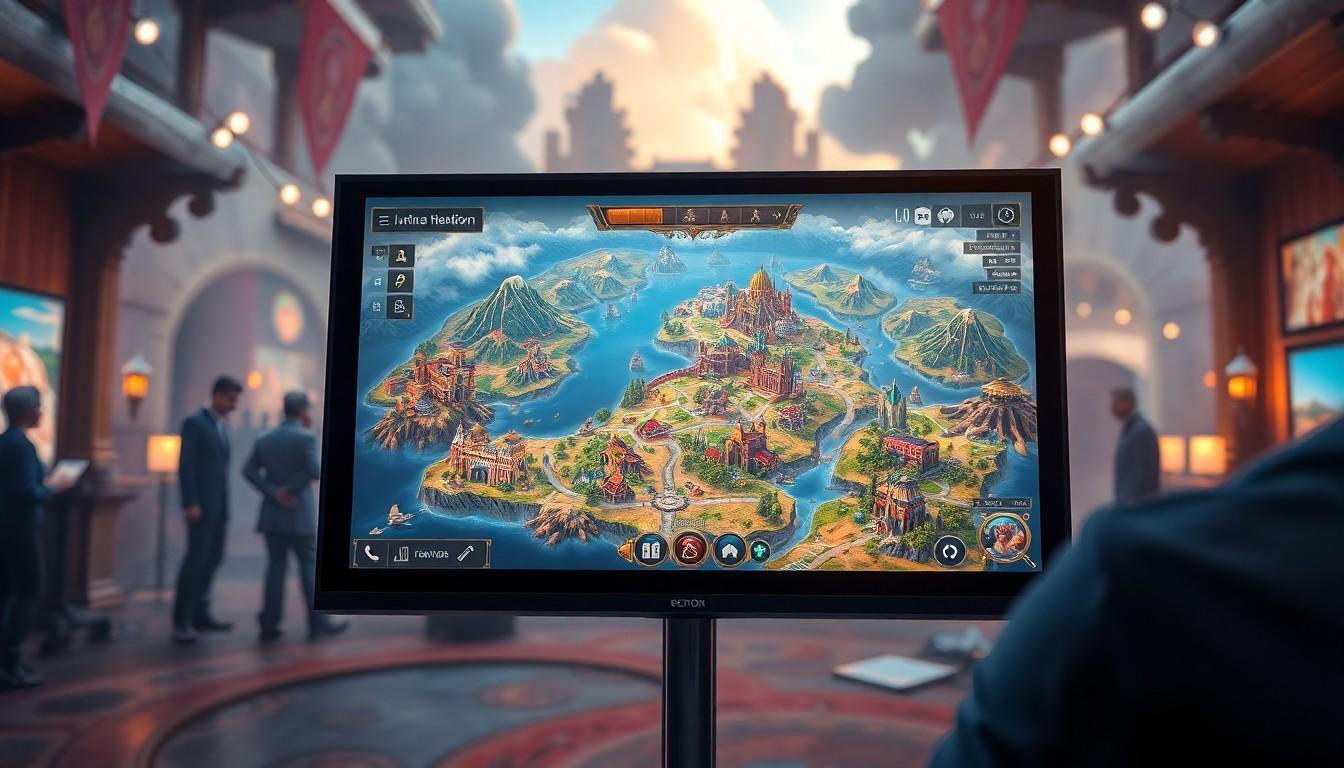In the ever-evolving landscape of digital gaming, maps play a crucial role in guiding players through uncharted territories and epic quests. Clienage9 takes this concept to a whole new level, transforming the way gamers navigate their virtual worlds. Imagine wielding a map that not only shows you where to go but also serves up surprises along the way.
Overview of Maps in Clienage9
Maps in Clienage9 provide players with an immersive experience. These interactive maps create dynamic environments where players navigate quests and discover hidden features. Players can explore unique landscapes tailored to various gaming styles.
Detailed information enhances player interaction with the maps. Oftentimes, the maps include landmarks, resource locations, and enemy territories, making navigation straightforward and strategic. Various in-game events are also highlighted on these maps, allowing players to plan accordingly.
Customization plays a significant role in user engagement. Users can personalize their maps, adjusting settings to reflect their preferences or gameplay needs. Clienage9 supports this adaptability, encouraging exploration and creativity.
Collaboration among players increases through shared maps. Teams can strategize together using a single map, improving coordination during multiplayer experiences. Each player’s unique insights contribute to overall team success.
The immediacy of map updates keeps the gaming experience fresh. Regularly refreshed data reflects game patches and updates, ensuring players interact with the latest information. This aspect fosters a sense of community, as players discuss new features and strategies linked to map changes.
Visual clarity is another priority within Clienage9’s maps. High-resolution graphics and intuitive design elements allow for easy comprehension. Interactive icons help update player progress, ensuring they remain aware of their objectives.
Overall, maps in Clienage9 embody a well-rounded tool that enriches gaming experiences through exploration, collaboration, and adaptability.
Key Features of Maps in Clienage9

Maps in Clienage9 offer several features that enhance the gaming experience and improve player engagement. These features include an intuitive user interface and robust navigation tools designed for optimal gameplay.
User Interface Design
User interface design focuses on clarity and ease of use. Players can easily access essential functions with concise menus. Customizable layouts allow individual preferences to shape the experience. High-resolution graphics present information effectively, creating vibrant visual elements that guide users. Interaction remains seamless, ensuring players follow quests and objectives without confusion. Overall, this streamlined design fosters a more immersive gaming environment, enabling players to focus on their adventures rather than navigating complex menus.
Navigation Tools
Navigation tools provide essential support for exploring game worlds. Interactive markers pinpoint resource locations and notable landmarks. Users can quickly identify enemy territories, improving strategic planning. Real-time updates keep navigation current, reflecting in-game changes for accuracy. Players benefit from customizable waypoints, allowing them to prioritize routes based on specific goals. These tools enhance exploration, promote collaboration in multiplayer scenarios, and elevate the overall gaming experience.
Comparison with Previous Versions
Maps in Clienage9 showcase significant advancements compared to earlier platform iterations. Enhanced interactive elements, previously limited, now create more engaging and immersive experiences for users. The dynamic environments reflect a broader range of player preferences, diverging from the static maps of prior versions.
Customization options for maps reach new heights. Users can tailor features and themes, fostering creativity in a way that past versions did not support extensively. The ability to share personalized maps encourages collaboration, marking a departure from solitary navigation experiences found in earlier releases.
Visual clarity has improved remarkably. High-resolution graphics offer vibrant imagery that was less pronounced in previous iterations. Intuitive design elements enhance usability, allowing players to focus on exploration without struggling to understand the interface.
Navigation tools provide essential upgrades. Real-time updates enhance accuracy, enabling smoother gameplay compared to older map versions that lacked timely information. Interactive markers for resource locations and enemy territories were minimal in earlier iterations, limiting strategic navigation.
User interface compatibility has evolved as well. Streamlined menus and customizable layouts allow for an enhanced user experience, contrasting sharply with former iterations that often overwhelmed users with cluttered interfaces.
Clienage9 ensures that maps stay relevant through regular updates, reflecting ongoing game patches more effectively than before. Community discussions thrive, driven by the introduction of new features, making it easier for players to develop and share strategies.
Overall, advancements in Clienage9 maps highlight a clear shift towards a more rich, collaborative, and player-focused gaming environment.
Benefits of Using Maps in Clienage9
Maps in Clienage9 offer numerous advantages that significantly enhance the gaming experience. Players achieve better navigation through diverse environments, simplifying the journey toward objectives. High-resolution graphics contribute to better visual comprehension, making it easier to recognize critical landmarks and resource locations.
Customization options empower users to personalize their maps, reflecting individual preferences and styles. Such tailored maps promote creativity, allowing exploration in ways that feel unique. Multiplayer coordination also improves through shared maps, fostering teamwork and strategic planning among players.
Regular updates contribute to the platform’s dynamism, ensuring maps remain current with game patches and new features. These updates encourage community engagement, as discussions about strategies and discoveries flourish.
Interactive markers on maps provide essential guidance, indicating resource spots and indicating enemy territories. Real-time updates enhance gameplay fluidity, allowing players to adapt their strategies as situations evolve. Customizable waypoints further support goal-oriented navigation, making it easier to tackle specific objectives.
Enhanced user interfaces simplify access to essential functions. Streamlined menus and intuitive design reduce confusion, allowing players to focus on the game rather than navigating the platform. These features collectively create an immersive experience that captivates players and boosts engagement.
Lastly, advancements in maps underline a commitment to a collaborative and player-centered environment. Rich interactive elements invite exploration and interaction, solidifying Clienage9 as a premier platform for gaming enthusiasts seeking vibrant, engaging experiences.
Challenges and Limitations
Maps in Clienage9 exhibit certain challenges and limitations that users encounter. Technical glitches can disrupt user experience, especially during high-demand periods. Connectivity issues may arise, affecting real-time updates and seamless navigation, leading to frustration among players.
User familiarity varies, creating accessibility challenges for newcomers. Some players may struggle to understand the interface, while others may find customization options overwhelming. Training for new users can enhance overall experience, but initial navigation might present hurdles.
Another limitation lies in the reliance on accurate data. Inaccurate resource locations or outdated landmarks can mislead players, impacting gameplay strategy. Community-driven content introduces variability in accuracy, as not all contributions undergo rigorous verification.
Map updates, though generally frequent, sometimes lag behind game patches. Timing discrepancies in updates can lead to confusion when players rely on current information for gameplay. Maintaining synchronization ensures enhanced player experiences, yet occasional oversight may occur.
Limited device compatibility also presents a challenge. Some users may attempt to access Clienage9 maps on older hardware, which can result in performance issues. Overall, optimizing map performance across diverse devices remains an ongoing goal.
Player feedback leads to continuous improvement efforts. However, adaptations based on user suggestions can take time to implement, as developers balance multiple priorities. These challenges highlight the need for ongoing enhancements within Clienage9, ensuring the platform remains user-friendly and effective.
Conclusion
Maps in Clienage9 represent a significant leap in the gaming experience. They not only guide players but also enrich their journeys with interactive elements and personalized features. The platform’s emphasis on collaboration and customization fosters a vibrant community where exploration thrives.
While challenges like technical glitches and user accessibility exist, ongoing improvements driven by player feedback ensure Clienage9 remains relevant and user-friendly. With regular updates and enhanced navigation tools, players can expect a dynamic and engaging environment that evolves alongside their gaming adventures. Clienage9 continues to set the standard for interactive maps, making it an essential tool for gamers looking to deepen their immersion and enjoyment.

